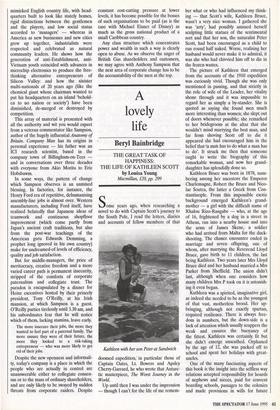A man is known
by the company that keeps him
Laurence Baron
COMPANY MAN by Anthony Sampson HarperCollins, f.20, pp. 319 Anthony Sampson's elegant and provocative study of the social history of corporate life, from the East India Compa- ny to Microsoft, raises a very tricky question: after so much change for the better, have we finished up with something worse?
Take, for a start, the old model of Company Man. In Britain he might have been a middle-manager in ICI or Shell, locked into a lifetime-employment pyramid of modest annual increments and triennial promotions, ready to go wherever the company sends him, equipped with a neat little wife who conformed precisely to the company's social expectations. In America, he might have been a Ford assembly-line worker, or a downtrodden clerk in a huge, regimented office like Jack Lemon in The Apartment, or an IBM salesman in a dark suit and a white shirt, staring at a sign saying 'Think' but not really encouraged to think at all. In Japan, he might have been madogiwa-zoku, which means sitting by the window without a real job at all.
But these traditional stereotypes, Sampson claims, are 'as extinct as an 18th- century clergyman'. Compare them with the new: the casually dressed software boffin on a short-term contract with a `down-sized' (or 'right-sized), de-layered, non-hierarchical corporation, whose head office looks like a Zen temple but has fewer desks than employees (`hot-desking) in order to encourage people to get out on the road or to lelecommute' from elsewhere. It is an organisation in which creative self-expression is admired, but traditional human communication has been replaced by e-mail, videophone and 'team- building' therapy; in which loyalty upwards or downwards has become a meaningless concept, the employee valuing his or her job chiefly in terms of the marketability it adds to the curriculum vitae.
Company Man places this transition in the context of underlying changes in social attitudes and economic forces, tracing its reflection in films and novels about office and factory life. Sampson illuminates, for example, the way in which companies built up in the Victorian and Edwardian eras mimicked English country life, with head- quarters built to look like stately homes, rigid distinctions between the gentlemen and the players, and low social status accorded to 'managers' — whereas in America as new businesses and new cities grew up together, industrialists were respected and celebrated as natural community leaders. He shows how the generation of anti-Establishment, anti- Vietnam youth coincided with advances in microchip electronics to produce the free- thinking alternative entrepreneurs of Silicon Valley: and how the sinister multi-nationals of 20 years ago (like the chemical giant whose chairman wanted to put his headquarters on an island 'behold- en to no nation or society') have been diminished, de-merged or destroyed by competition.
This array of material is presented with all the authority and wit you would expect from a veteran commentator like Sampson, author of the hugely influential Anatomy of Britain. Company Man has its origins in personal experience — his father was an ICI research scientist, based in . the company town of Billingham-on-Tees and in conversations over three decades with everyone from Akio Morita to Eric Hobsbawm.
In some ways, the pattern of change which Sampson observes is an unmixed blessing. In factories, for instance, the Henry Ford era of repetitive, dehumanising assembly-line jobs is almost over. Western manufacturers, including Ford itself, have realised belatedly that Japanese ideas of teamwork and continuous shopfloor improvement (which come partly from Japan's ancient craft traditions, but also from the post-war teachings of the American guru Edwards Demming, a prophet long ignored in his own country) make for undreamed-of levels of efficiency, quality and job satisfaction.
But for middle-managers, the price of meritocracy, creative freedom and a more varied career path is permanent insecurity, stripped of the comforts of corporate paternalism and collegiate trust. The paradox is encapsulated by a dinner for Heinz executives hosted by their princely president, Tony O'Reilly, at his Irish mansion, at which Sampson is a guest. O'Reilly parties tirelessly until 3.30 am, and his subordinates fear that he will notice which of them, lacking stamina, leave early.
The more insecure their jobs, the more they wanted to feel part of a paternal family. The more unsure they were of their future, the more they looked to a risk-taking entrepreneur — who was more likely to get rid of their jobs.
Despite the new openness and informali- ty, today's company is a place in which the people who are actually in control are unanswerable either to collegiate consen- sus or to the mass of ordinary shareholders, and are only likely to be swayed by sudden threats from corporate raiders. Despite constant cost-cutting pressure at lower levels, it has become possible for the bosses of such organisations to be paid (as is the case with Michael Eisner of Disney) as much as the gross national product of a small Caribbean country.
Any class structure which concentrates power and wealth in such a way is clearly open to abuse. As we observe the anger of British Gas shareholders and customers, we may agree with Anthony Sampson that the next area of corporate change has to be the accountability of the men at the top.



































































 Previous page
Previous page